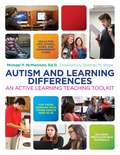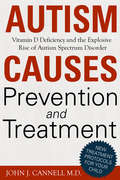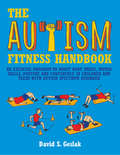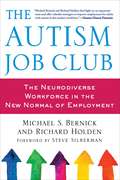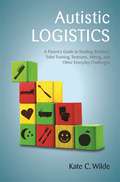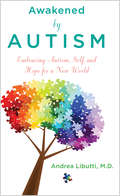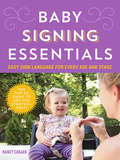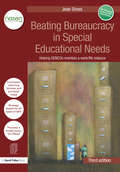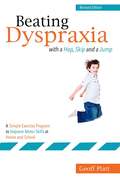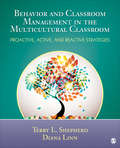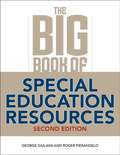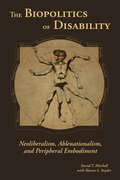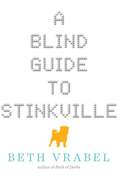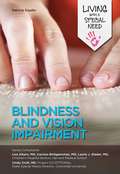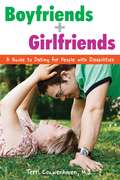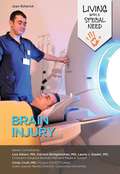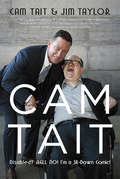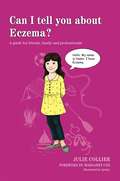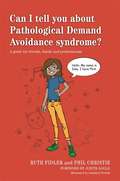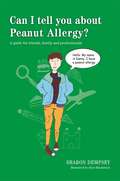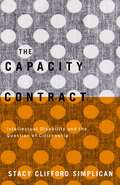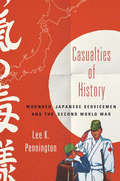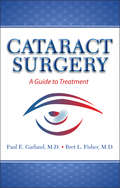- Table View
- List View
Autism and Learning Differences: An Active Learning Teaching Toolkit
by Stephen M. Shore Michael P. McmanmonTeaching essential skills for life, school, work, and independent living, this comprehensive and practical toolkit supports educators and clinicians in their work with adolescents and young adults with an Autism Spectrum Disorder (ASD) or Learning Difference (LD) diagnosis. It presents tried-and-true strategies that address difficulties with social skills and Executive Function, cognitive rigidity, self-esteem issues, and more. It includes: - Focused chapters on skills for life, school, work, and independent living - Photocopiable teaching materials and tips for classroom management - Sections on peer-mentoring, mediation, and inclusion - Assessment strategies, including student self-assessment materials and feedback forms - Contributions from experts in the field, including Dr. Stephen Shore, Liane Holliday Willey, Dr. Brenda Smith Myles, Barbara Bissonnette and Jennifer Cook O'Toole. Drawing on over 30 years' teaching experience at the College Internship Program (CIP), Dr. Michael P. McManmon's toolkit is a complete curriculum for educators, clinicians, and professionals who teach or advise young adults on the ASD or LD Spectrum. It can also be used effectively by parents and individuals for self-study.
Autism Causes, Prevention & Treatment
by John CannellIn this groundbreaking work, autism researcher John Cannell, MD, provides the most comprehensive and compelling explanation to date regarding autism causes, prevention strategies, and treatment protocols that, in many cases, reverse symptoms.
The Autism Fitness Handbook: An Exercise Program to Boost Body Image, Motor Skills, Posture and Confidence in Children and Teens with Autism Spectrum Disorder
by Stephen M. Shore David GeslakDesigned to address specific areas of difficulty for children, teens and young adults with autism spectrum disorder (ASD), the 46 exercises in this comprehensive program are proven to improve body image, motor coordination, posture, muscular and cardiovascular fitness. The boost to confidence, relationships and general wellbeing resulting from this will be transformative for individuals with ASD and their families. Used extensively in homes, schools and specialist ASD programs, the exercises require minimal equipment and can be used in a wide range of settings. Accompanied by clear instructions and explanatory cartoon illustrations, they are easy for non-specialists to follow and can be used just as effectively with groups or individuals. Packed with helpful advice from the author, an ASD fitness specialist, as well as inspiring case studies and guidelines on adapting the exercises for different ages and abilities, this popular program contains everything needed to get minds and bodies active while having fun!
The Autism Job Club: The Neurodiverse Workforce in the New Normal of Employment
by Michael Bernick Richard Holden Steve SilbermanThe Autism Job Club is a groundbreaking book for bringing adults with autism and other neuro-diverse conditions into the work world. This second edition of The Autism Job Club includes a new Foreword by Steve Silberman, author of the best-selling NeuroTribes, along with an Afterword by the authors. The Afterword covers the many employment initiatives for adults on the autism spectrum launched just in the three years since the book was originally published. The book has its basis in the autism job club that the authors have been part of in the San Francisco Bay Area, the job-creation and job-placement efforts the club has undertaken, and similar efforts throughout the United States. The authors review the high unemployment rates among adults with autism and other neuro- diverse conditions more than two decades after the ADA. Bernick and Holden also outline and explain six strategies that, taken together, will reshape employment for adults with autism: the art of the autism job coach; the autism advantage in technology employment; autism employment and the internet economy; autism employment and the practical/craft economy; autism and extra-governmental job networks; autism and public service employment.The Autism Job Club is a vital resource for adults with autism, their families, and advocates who are committed to neuro-diverse employment, not unemployment. But it also speaks to a far broader audience interested in how to carve out a place for themselves or others in an increasingly competitive job world.
Autistic Logistics: A Parent's Guide to Tackling Bedtime, Toilet Training, Tantrums, Hitting, and Other Everyday Challenges
by Kate WildeHave you ever wished that your child with autism spectrum disorder (ASD) came with a manual? This book provides just that, offering clear, precise, step-by-step advice on everything you want to know, including: - How to toilet train your child without pushing or pressuring - How to get your child to sleep in their own bed and through the night - What to do when your child tantrums, hits or bites - How to introduce new foods, without a fight Based on decades of experience, Kate Wilde tackles these day-to-day issues and more, using tried-and-tested techniques to help you transform the challenges of home life and create harmony. The unique approach featured in the book, which encourages you to support your child's need for control rather than fight against it, can have transformative results. Not only will you learn to see through your child's eyes and help your child in a way that honors his/her specialness, but you will also begin to free yourself from the pressure and discomfort that can so often accompany everyday challenges. Catering to all age ranges and points on the spectrum, this book will be of immeasurable value to parents and caregivers of children with autism, other family members, as well as teachers and teaching assistants.
Awakened by Autism: A Journey Of Embracing Autism, Self, And Hope For A New World
by Andrea LibuttiAndrea Libutti began the work of reconstructing herself after her oldest son was diagnosed with severe autism several years ago. Distraught and seemingly hopeless at the time, a series of unfolding events moved her from sleepwalking through life toward a personal journey of inner transformation. She immersed herself in research surrounding the causes and treatments for autism, and after several years of learning she has come to understand the disorder from a physical, emotional, and spiritual perspective.In Awakened by Autism, Andrea shares her journey and the knowledge she has gained along the way. She believes that the masses of children diagnosed today with autism are here to teach us some important lessons about the world we have created. Humanity has gotten off track-often motivated by profit-leaving our bodies and our planet overburdened with toxins, and our families exhausted, stressed, and broken. It is for these very reasons that autism has emerged as an epidemic and a calling for humanity to wake up. We cannot continue to deplete our planet and our souls and still expect our children to thrive. Awakened by Autism is both a memoir and a practical guide for healing our children-and a starting point for healing our planet.
Baby Signing Essentials
by Nancy CadjanStart "talking" with your baby today and discover what they're really trying to tell youWith the gift of sign language, you can communicate with your child as early as four to six months, reduce tantrums, build verbal language skills, and create a stronger bond than ever! Using trusted American Sign Language (ASL), Baby Signing Essentials is the go-to guide for parents, caregivers, and educators looking to create effective two-way communication. Designed to grow with your baby by covering physical, emotional, mental, and linguistic development at each age, this shows you how to start signing right from your baby's birth or later on. Featuring: 200 illustrated ASL signs (including 50 essential signs like MILK, MORE, and EAT) Easy-to-follow instructions to help you make each sign correctly Age-specific advice on working with infants, toddlers, and beyond Fun tips to incorporate signing into daily routines
Beating Bureaucracy in Special Educational Needs: Helping SENCOs maintain a work/life balance (nasen spotlight)
by Jean GrossAre you overwhelmed by the amount of paperwork that SEN generates in your school? Would you like to spend more time actually improving the quality of teaching and learning for pupils with SEN or disabilities? If so, this is an essential book for you. Fully revised and updated for the 2014 SEN Code of Practice, this new edition contains strategies for reducing the number of individual education plans and review meetings. Beating Bureaucracy in Special Educational Needs will help you to use existing systems for target setting, recording and planning – personalised systems that are used for all children as part of everyday teaching practices. It lists the intervention programmes that really work and showcases the work of four schools that have successfully developed ways of planning provision, working with parents, and supporting staff development. Ready-to-use proforma in the book are also available online, and include a model policy for Ofsted; strategy sheets for all main types of SEN; provision maps and proformas to help you plan, monitor and evaluate your provision Beating Bureaucracy in Special Educational Needs will provide support for school leaders, SENCOs and anyone undertaking the national SENCO award. A practical and engaging guide, this new and updated edition shows how to put responsibility for supporting children with most types of additional need firmly back where it belongs – with class and subject teachers. It will help you – in the words of one SENCO – ‘get your life back’.
Beating Dyspraxia with a Hop, Skip and a Jump: A Simple Exercise Program to Improve Motor Skills at Home and School Revised Edition
by Geoffrey PlattGeoff Platt's exercise program, tailored to help children with dyspraxia to overcome their symptoms, enjoy physical activities, and become as active as their friends and classmates, is now proven to be even more effective. This revised edition outlines the fun and easy-to-teach program, which focuses on familiar activities such as running, jumping and ball play, and explains how regular exercise routines can reduce weakness and improve motor skills, such as balance, timing and coordination. It includes extra session plans, incorporates new research, and adds a secondary stage to the exercise program, teaching the skills of praxis, planning movement and improving skills. This practical guide will be an essential resource for Physical Education teachers and non-specialist teachers of recreation and games classes who are looking to help children with dyspraxia to reduce weakness and improve motor skills, as well as parents.
Behavior and Classroom Management in the Multicultural Classroom: Proactive, Active, and Reactive Strategies
by Terry L. Shepherd Diana LinnAddressing the increasing number of culturally and linguistically diverse students in today’s schools, Behavior and Classroom Management in the Multicultural Classroom, by Terry L. Shepherd and Diana Linn, provides general and special education teachers with the knowledge, skills, and strategies to make the proactive, active, and reactive interventions necessary to create a positive classroom environment in which all students can learn. Going beyond the traditional rules and hierarchy of consequences and reinforcements, the book demonstrates how to incorporate basic classroom management plans, functional behavioral analysis, functional behavioral assessments, and behavioral intervention plans into the development and implementation of response-to-intervention and school-wide positive behavior support programs. In every chapter, the authors use real world examples and case studies to explore how language and culture affect students’ responses to behavior and classroom management. Unique chapters cover social skills training and collaborating with families of diverse students.
Behavior and Classroom Management in the Multicultural Classroom: Proactive, Active, and Reactive Strategies
by Terry L. Shepherd Diana LinnAddressing the increasing number of culturally and linguistically diverse students in today’s schools, Behavior and Classroom Management in the Multicultural Classroom, by Terry L. Shepherd and Diana Linn, provides general and special education teachers with the knowledge, skills, and strategies to make the proactive, active, and reactive interventions necessary to create a positive classroom environment in which all students can learn. Going beyond the traditional rules and hierarchy of consequences and reinforcements, the book demonstrates how to incorporate basic classroom management plans, functional behavioral analysis, functional behavioral assessments, and behavioral intervention plans into the development and implementation of response-to-intervention and school-wide positive behavior support programs. In every chapter, the authors use real world examples and case studies to explore how language and culture affect students’ responses to behavior and classroom management. Unique chapters cover social skills training and collaborating with families of diverse students.
The Big Book of Special Education Resources
by Roger Pierangelo George GiulianiThere are abundant resource in the field of special education for professionals and parents of children with special needs. However, it can be a daunting task to navigate through this sea of organizations, Web sites, books, and other resources in order to find exactly what you need.Save time and take the guesswork out of your search for information and materials by turning to this definitive guide. Practical and easy to use, this ready-reference is borne out of extensive research and numerous interviews with parents and professionals to ensure selection of only the highest-caliber and most sought-after resources. Covering everything from federal agencies and professional organizations to IEP information and lesson plans, and providing extensive resources for all 50 states, The Big Book of Special Education Resources is the most comprehensive collection of its kind. The book includes:* Contact information for and descriptions of dozens of clearinghouses and national disability organizations* Thousands of pertinent toll-free numbers and Web sites for all areas of special education* Reputable books, videos, and journals on specific topics in special education* State-by-state directory of agencies, disability-specific organizations, and parent groups* Additional Comprehensive resource sections covering behavior issues, IDEA and IEP navigation, reputable sources of teaching strategies and materials, and moreSave yourself hours of hassle and frustration by picking up The Big Book of Special Education Resources, Second Edition, and putting the most up-to-date and reputable resources in every area of special education right at your fingertips.
The Biopolitics Of Disability: Neoliberalism, Ablenationalism, And Peripheral Embodiment
by David T. MitchellIn the neoliberal era, when human worth is measured by its relative utility within global consumer culture, selected disabled people have been able to gain entrance into late capitalist culture. The Biopolitics of Disability terms this phenomenon "ablenationalism" and asserts that "inclusion" becomes meaningful only if disability is recognized as providing modes of living that are alternatives to governing norms of productivity and independence. Thus, the book pushes beyond questions of impairment to explore how disability subjectivities create new forms of embodied knowledge and collective consciousness. The focus is on the emergence of new crip/queer subjectivities at work in disability arts, disability studies pedagogy, independent and mainstream disability cinema (e. g. , Midnight Cowboy), internet-based medical user groups, anti-normative novels of embodiment (e. g. , Richard Powers's The Echo-Maker) and, finally, the labor of living in "non-productive" bodies within late capitalism.
Blind Guide to Stinkville
by Beth VrabelBefore Stinkville, Alice didn’t think albinism--or the blindness that goes with it--was a big deal. Sure, she uses a magnifier to read books. And a cane keeps her from bruising her hips on tables. Putting on sunscreen and always wearing a hat are just part of life. But life has always been like this for Alice. Until Stinkville. For the first time in her life, Alice feels different--like she’s at a disadvantage. Back in her old neighborhood in Seattle, everyone knew Alice, and Alice knew her way around. In Stinkville, Alice finds herself floundering--she can’t even get to the library on her own. But when her parents start looking into schools for the blind, Alice takes a stand. She’s going to show them--and herself--that blindness is just a part of who she is, not all that she can be. To prove it, Alice enters the Stinkville Success Stories essay contest. No one, not even her new friend Kerica, believes she can scout out her new town’s stories and write the essay by herself. The funny thing is, as Alice confronts her own blindness, everyone else seems to see her for the first time. This is a stirring small-town story that explores many different issues--albinism, blindness, depression, dyslexia, growing old, and more--with a light touch and lots of heart. Beth Vrabel’s characters are complicated and messy, but they come together in a story about the strength of community and friendship.
Blindness and Vision Impairment
by Patricia SouderIt's impossible to predict all the ways that being blind will affect a person's life. From relearning things like reading and moving around, to the emotional impact of not being able to see, blindness and vision impairments present people with a whole new set of difficult challenges. In this book, as you read the story of Kyla's vision impairment, you'll learn about many of the disorders and injuries that can cause blindness and impaired vision. You'll also find out about the techniques and services used to treat and deal with blindness, including guide animals, white canes, Braille, and programs such as special summer camps. Becoming blind doesn't have to get in the way of leading a fulfilling life!
Boo's Beard
by Rose ManneringTom can’t read facial expressions, so he doesn’t understand the other children and they don’t understand him. Playing at the park can be lonely sometimes, but luckily Tom has his dog, Boo, and Boo is easy to understand. She wags her tail when she is happy and whines when she is sad. One day, Boo gets her beard all knotted up in the bushes. A little girl named Lydia sees Boo and stops to talk to Tom. Boo’s beard has been tangled into a big smile, and Lydia explains to Tom that it’s the expression that someone makes when she is happy. She twists Boo’s beard into more expressions, explaining each one as she goes. When Lydia invites Tom and Boo to play on the swings with the kids, Tom and Boo join her. And at the end of the book, Tom understands the meaning of his own smile. This sweet book familiarizes children with social disabilities, such as autism and Asperger’s syndrome. Children learn the meaning of facial expressions and are introduced to the possibility that some children may have difficulty interacting with them.
Boyfriends and Girlfriends: A Guide to Dating for People with Disabilities
by Terri CouwenhovenEveryone knows that dipping your toe in the dating pond can be a little intimidating without first seeking some expert advice! And that's exactly what Terri Couwenhoven delivers in this book written expressly for teens and adults with intellectual or developmental disabilities. "Boyfriends & Girlfriends" explains the dos and don'ts of dating and validates their normal, age-appropriate desire for companionship and romance. The book covers the biggest questions and smallest concerns of every would-be dater, including: Who is an appropriate dating partner and who is not. How to read signals and judge whether the interest is mutual. How to ask someone out on a date. How to turn down a date. How to handle rejection. What sexual feelings are. How to work through problems in a relationship. What to do when a relationship is not working. Written and illustrated for a hi/lo reader, this book is perfect for anyone who is already in a relationship, ready to start one, or still only dreaming about it. The guide is also an informative read for parents, counsellors, and other support providers.
Brain Injury
by Joan EsherickThe human brain is a fragile organ, and as a result, brain damage is all too common. Tumors, strokes, accidents, gunshots, and impacts to the skull can all cause brain injury. These injuries can be minor--or they might cause memory loss or the inability to move normally. Many people who suffer brain injuries must relearn how to walk, talk, and do basic things like tie their shoes. In this book, you'll read the story of Jerome, a boy who suffered a dangerous head injury while riding his bicycle. You'll learn how schools, doctors, and others are helping people like Jerome regain control of their lives.
Cam Tait
by Jim Taylor Cam Tait"I have cerebral palsy much like I have blue eyes and have-or should I say had?-brown hair. It is simply a part of who I am. When I speak to groups about my situation I can even joke about it. 'Think of CP as Canada Post,' I tell them. 'My brain sends out signals, and God knows where they wind up.'" Long-time journalist Cam Tait has seen some interesting times on the sports beat-rolling alongside Rick Hansen in the Man in Motion tour, playing in fundraising golf tournaments, and tipping back some cold ones with Wayne Gretzky, to name a few. His personal life hasn't lacked excitement either-memorable moments include parasailing, winning a stand-up (or in his case, sit-down) comedy contest, and helping his grandson take his first steps. But he couldn't have done it without the help of his friends. Tait was born with cerebral palsy, unable to sit up, speak or move his arms and legs. But thanks to a revolutionary form of physical therapy that required a 24/7 commitment from his parents and a team of 116 volunteers, he learned to get around in a wheelchair, move his hands and talk. These turned out to be useful skills for a career of prime interviews, crazy deadlines and pranks. Tait teams up with friend and fellow journalist Jim Taylor, telling his own story with characteristic directness and humour. With a newspaperman's inveterate sense of timing, Tait moves seamlessly from one-liners and tales of debauched hijinks to candid accounts of his depression, career struggles and loss of loved ones. He speaks with eloquence about the importance of giving disabled people the chance to pursue their ambitions, and the value of all the support he's received in achieving his own dreams. In both his career and personal life, he's experienced the power of humour to break down barriers and bring people together-and have a hell of a good time doing it.
Can I tell you about Eczema?: A guide for friends, family and professionals
by Julie Collier Apsley Margaret CoxMeet Helen - a girl with eczema. Helen invites readers to learn about this skin condition from her perspective, describing how it feels to have itchy and inflamed skin nearly all the time. She explains how different creams, ointments and other treatments can help her skin to feel better and lets readers know about other ways she can be helped and supported. This illustrated book is ideal for young people aged 7 upwards, as well as parents, friends, teachers and nurses. It is also an excellent starting point for family and classroom discussions.
Can I tell you about Pathological Demand Avoidance syndrome?: A guide for friends, family and professionals
by Phil Christie Ruth Fidler Jonathon Powell Judith GouldMeet Issy - an 11-year-old girl with pathological demand avoidance syndrome (PDA), a condition on the autism spectrum. Issy invites readers to learn about PDA from her perspective, helping them to understand how simple, everyday demands can cause her great anxiety and stress. Issy tells readers about all the ways she can be helped and supported by those around her. This illustrated book is for readers aged 7 and upwards, and will be an excellent way to increase understanding about PDA in the classroom or at home. It also includes practical tips and recommended resources for parents and professionals.
Can I tell you about Peanut Allergy?: A guide for friends, family and professionals
by Sharon Dempsey Alice BlackstockMeet Danny - a boy with a peanut allergy. He explains that peanut allergies can be very serious, but once you know how to manage them, they don't have to get in the way of living a fun and full life. Danny talks about what a peanut allergy is, what do to in an emergency, and how his friends and family can help him to live a nut free life. He also shares advice on coping with a peanut allergy on special occasions and trips away. This illustrated book is ideally suited for readers aged 7 and upwards, and will be an excellent way to increase awareness about peanut allergies, in the classroom or at home. It also includes clear, useful information for parents and professionals.
The Capacity Contract
by Stacy Clifford SimplicanIn the first sustained examination of disability through the lens of political theory, The Capacity Contract shows how the exclusion of disabled people has shaped democratic politics. Stacy Clifford Simplican demonstrates how disability buttresses systems of domination based on race, sex, and gender. She exposes how democratic theory and politics have long blocked from political citizenship anyone whose cognitive capacity falls below a threshold level marginalization with real-world repercussions on the implementation of disability rights today. Simplican's compelling ethnographic analysis of the self-advocacy movement describes the obstacles it faces. From the outside, the movement must confront stiff budget cuts and dwindling memberships; internally, self-advocates must find ways to demand political standing without reinforcing entrenched stigma against people with profound cognitive disabilities. And yet Simplican's investigation also offers democratic theorists and disability activists a more emancipatory vision of democracy as it relates to disability one that focuses on enabling people to engage in public and spontaneous action to disrupt exclusion and stigma. Taking seriously democratic promises of equality and inclusion, The Capacity Contract rejects conceptions of political citizenship that privilege cognitive capacity and, instead, centers such citizenship on action that is accessible to all people.
Casualties of History: Wounded Japanese Servicemen and the Second World War (Studies of the Weatherhead East Asian Institute, Columbia University)
by Lee K. PenningtonThousands of wounded servicemen returned to Japan following the escalation of Japanese military aggression in China in July 1937. Tens of thousands would return home after Japan widened its war effort in 1939. In Casualties of History, Lee K. Pennington relates for the first time in English the experiences of Japanese wounded soldiers and disabled veterans of Japan's "long" Second World War (from 1937 to 1945). He maps the terrain of Japanese military medicine and social welfare practices and establishes the similarities and differences that existed between Japanese and Western physical, occupational, and spiritual rehabilitation programs for war-wounded servicemen, notably amputees. To exemplify the experience of these wounded soldiers, Pennington draws on the memoir of a Japanese soldier who describes in gripping detail his medical evacuation from a casualty clearing station on the front lines and his medical convalescence at a military hospital. Moving from the hospital to the home front, Pennington documents the prominent roles adopted by disabled veterans in mobilization campaigns designed to rally popular support for the war effort. Following Japan’s defeat in August 1945, U.S. Occupation forces dismantled the social welfare services designed specifically for disabled military personnel, which brought profound consequences for veterans and their dependents. Using a wide array of written and visual historical sources, Pennington tells a tale that until now has been neglected by English-language scholarship on Japanese society. He gives us a uniquely Japanese version of the all-too-familiar story of soldiers who return home to find their lives (and bodies) remade by combat.
Cataract Surgery: A Guide to Treatment
by Bret L Fisher Paul E GarlandHaving cataract surgery? Nearly 3 million Americans who have cataracts removed each year. In fact, it's the most commonly performed surgery in the nation. And, the numbers are expected to increase--by the year 2020, nearly 30 million Americans will have cataracts. Even though cataract surgery is a common procedure, you may find yourself feeling anxious about an operation on your eye. Ophthalmologists Paul E. Garland, M.D. and Bret L. Fisher, M.D., have performed thousands of cataract surgeries, and they understand your questions and concerns. They answer questions such as: How long should you wait to have cataract surgery? What type of anesthesia is used? How is the cataract actually removed?
